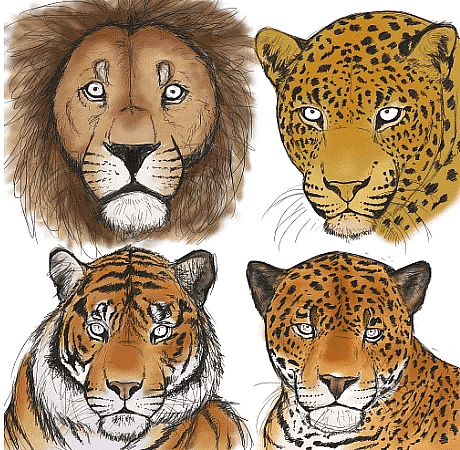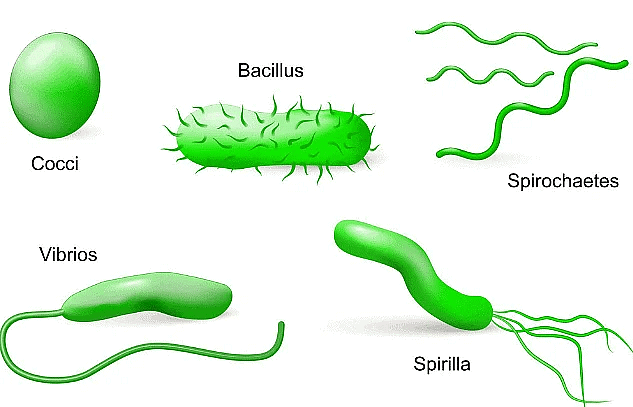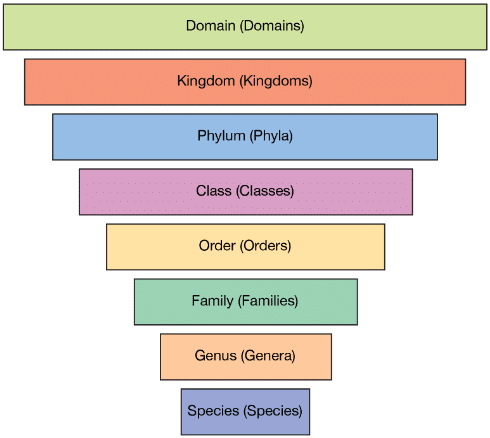NCERT Solutions Class 11 Biology Chapter 1 - The Living World
Q1: Why are living organisms classified?
Ans: Organisms are classified because of the following reasons:
- There are millions of organisms on Earth. Classification based on similarities and dissimilarities makes the study of the organisms easier. Characteristics of a model organism of a taxon are similar to that of other organisms placed in the same taxon. Therefore, it eliminates the need to study all the organisms.
- Classification helps in the identification of organisms.
- It helps to establish the phylogenetic or ancestral relationship among organisms.
- Classification helps in comparing organisms of the same or different taxa.
OR
Living organisms are classified because of the following reasons:
- Easy identification.
- Study of organisms of other places.
- Study of fossils.
- Grouping helps in study of all types of organisms while it is impossible to study individually all of them.
- It brings out similarities and dissimilarities. They help in knowing relationships among different groups.
- Evolution of various taxa can be known.
Q2: Why are the classification systems changing every now and then?
Ans:
- Evolution is the major factor responsible for the change in classification systems. Since evolution still continues, so many different species of plants and animals are added to the already existed biodiversity. These newly discovered plant and animal specimens are then identified, classified, and named according to the already existing classification systems.
- Since, evolution still continues, so many different species of plants and animals are added in the already existed biodiversity.
- From very early days till now biologists use several characters for classification system. These are morphology, anatomy, cytology, physiology, ontogeny, phylogeny, reproduction, biochemistry, etc. But day by day biologists are learning something new about organisms from their fossil records and using” advanced study techniques such as molecular phylogeny, etc. So their point of view about classification keeps changing. Thus the system of classification is modified every now and then.
Q3: What different criteria would you choose to classify people that you meet often?
Ans: The people we come across in our daily life can be classified on the basis of:
- Their gender (male or female)
- Morphological characteristics such as height, weight, the colour of their eyes or hair
- Areas they live in, or states they belong to.
- Level of education or favourite subjects or sport, etc.
Q4: What do we learn from identification of individuals and populations?
- The identification of individuals based on their characteristics helps us to know how an individual differs from the other members of the population and at what points it is similar to the population.
- It also helps us in deriving relationships between individuals of different populations. Such relationships help in classifying organisms in their right groups.
- Learning the characteristics of the populations aid in the study of that population as well as how it can be related to the other populations.
- Through this practice, one can establish evolutionary relationships between different populations.
- Also, By identifying individuals and populations, we learn the following things
- (i) Skin colour
(ii) Sex of the individual
(iii) Native place
(iv) Mother tongue
(v) Food habit
(vi) Religion
(vii) Caste
(i) Mangifera Indica
(ii) Mangifera indica
In the binomial system of nomenclature, the generic name of a species always starts with a capital letter whereas the specific name starts with a small letter. Both the names are typed or printed in italics or underlined separately when hand-written. Therefore, the correct scientific name of Mango is Mangifera indica.
 Mangifera indica
Mangifera indicaAns: A particular level of hierarchy in the classification of living beings is called a taxon. A taxon is a group of one or more populations of an organism or organisms seen by taxonomists to form a unit.
Following are the hierarchical levels:
(i) Kingdom
(ii) Phylum
(iii) Class
(iv) Order
(v) Family
(vi) Genus
(vii) Species
Example: Insects represent a class of phylum-Arthropoda. All the insects possess common characters of three pairs of jointed legs.
Example of taxa for human: Phylum — Chordata; Class — Mammalia; Order — Primates; Family — Hominidae; Genus — Homo; Species — sapiens
Q7: Can you identify the correct sequence of taxonomical categories?
(a) Species → Order → Phylum → Kingdom
(b) Genus → Species → Order → Kingdom
(c) Species → Genus → Order → Phylum
Ans: (a) and (c)
The correct hierarchical arrangement of taxonomic categories in ascending order is:
Species → Genus → Family → Order → Class → Phylum → Kingdom
Therefore, both (a) and (c) represent correct sequences of taxonomic categories. In sequence (b), species should be followed by genus. Therefore, it does not represent the correct sequence.
Q8: Try to collect all the currently accepted meanings for the word ‘species’. Discuss with your teacher the meaning of species in case of higher plants and animals on one hand, and bacteria on the other hand.
Ans: In biological terms, species is the basic taxonomical rank. It can be defined as a group of similar organisms that are capable of interbreeding under natural conditions to produce fertile offspring. Therefore, a group of similar individuals are respectively isolated form a species. Species can also be defined as a group of individuals that share the same gene pool.
- A group of individual organisms with fundamental similarities is called species.
- It can be distinguished from other closely related species on the basis of distinct morphological differences.
- In case of higher plants and animals, one genus may have one or more than one species, e.g., Panthera leo (lion) and Panthera tigris (tiger). In this example, Panthera is a genus, which includes leo (lion) and tigris (tiger) as species.
 Genus Panthera
Genus Panthera
- In the case of bacteria, different categories are present on the basis of shape. These are spherical, coccus, rod-shaped, comma and spiral-shaped. Thus, the meaning of species in case of higher organisms and bacteria are different.
 Shapes of Bacteria
Shapes of Bacteria
Q9: Define and understand the following terms:
(i) Phylum
(ii) Class
(iii) Family
(iv) Order
(v) Genus
Ans:
- Phylum: It is a principal taxonomic category that comes above class and below kingdom. It is a group or taxon of one or several related classes. In botany, the term Division is used for plants instead of the phylum.
Example: Chordata is a phylum. It contains all those organisms that have or at some point during their development had a notochord. - Class: It is a taxonomical rank that ranks above Order and below phylum. Class is a group or taxon of one or more related orders.
Example: Mammalia is a class. It contains all those chordate organisms that have characteristic features of mammals like fur, mammary glands, and warm-bloodedness. - Family: This taxonomical rank contains a group of related genera. It is classified between order and genus.
Example: The cat belongs to the family, Felidae. This means that all animals that are chordates, mammals, and carnivorous having characteristic cat-like features would belong to this family. So cats, lions, tigers, leopard all belong to the family Felidae. - Order: Order is a taxonomic rank that exists below class and above family and is made up of families sharing a set of similar nature or characters.
Example: Primata is an order which contains all the primates. - Genus: A genus is a taxonomic rank that ranks above species and below family, and is denoted by a capitalized Latin name.
Example: Mangifera. Genus is also known as a generic name. It is a group or taxon of one or several related species.
Q10: Illustrate the Taxonomical hierarchy with suitable examples of a plant and an animal.
Ans: The arrangement of various taxa in hierarchical order is called taxonomic hierarchy. In this hierarchy, species are present at the lowest level, whereas the kingdom is present at the highest level.

Classification of a Plant: As an example, let us classify Solanum melongena (Brinjal):
- Kingdom – Plantae
- Division – Angiospermae
- Class – Dicotyledonae
- Order – Solanales
- Family – Solanaceae
- Genus – Solanum
- Species – melongena
Classification of an Animal: As an example, let us classify Columba livia (Blue rock Dove):
- Kingdom – Animalia
- Phylum – Chordata
- Class – Aves
- Order – Columbiformes
- Family – Columbidae
- Genus – Columba
- Species – livia
Old NCERT Solution
Q1: How is a key helpful in the identification and classification of an organism?
Ans:
- Keys are based on similarities and dissimilarities in characters, generally in a pair called a couplet.
- Each statement in the key is called a lead. Separate taxonomic keys are required for each taxonomic category such as family, genus, and species for identification purposes. Keys are generally analytical in nature.
- keys are aids for rapid identification of unknown plants and animals based on the similarities and dissimilarities.
- Keys are primarily based on stable and reliable characters.
- The keys are helpful in a faster preliminary identification which can be backed up by confirmation through comparison with detailed description of the taxon provisionally identified with.
- Separate taxonomic keys are used for each taxonomic category like Family, Genus and Species.
Example: Animals with or without organs. It represents the choice made between two opposite options. This results in the acceptance of only one and the rejection of the other.
|
180 videos|367 docs|148 tests
|
FAQs on NCERT Solutions Class 11 Biology Chapter 1 - The Living World
| 1. What is the importance of studying the living world? |  |
| 2. How do scientists classify living organisms? |  |
| 3. What is the significance of binomial nomenclature in naming living organisms? |  |
| 4. How do species interact with each other in an ecosystem? |  |
| 5. Why is biodiversity important for the survival of living organisms? |  |


















